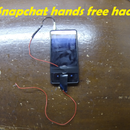Introduction: Electromagnetic Cannon (coil Gun)
Hello everyone,
In this work I will show you how does electromagnetic cannon work. Main principle of work is that you have some coil and you let current through it, coil generates magnetic field and because of it, the nail, which is in coil, gets launched. You will find out more details in further steps.
I would be grateful if you vote for me, of course, if you like that project. :-)
BE VERY CAREFUL OF HIGH VOLTAGE, CAPACITOR DISCHARGING IS NOT A GAME, YOU CAN GET KILLED!!
Step 1: Introduction
Electromagnetic gun is a device that uses a magnetic field to accelerate the projectile made from the ferromagnetic material. The basic principle is very simple, but in practical execution occurs many problems and complications which together caused small efficiency of cannon. From the initial invested energy only a few percent is converted into kinetic energy of projectile. In basic of thisbeffect is a number of energy conversion. Electrostatic energy of the capacitor is converted into magnetic energy of the coil, and then this energy is converted into kinetic energy projectiles. At each conversion, the energy is lost so the final efficiency can't be high.
About power supply:
We gathered a dozen electrolytic capacitors and connect them in parallel to the battery capacity C = 5.0 mF allowed voltage 400V. According to the capacitor battery we designed the rest of the device. We powered the battery from local powerline (220V) through the regulation transformer and rectifier.
Measuring the speed and energy of projectile:
In order to measure the energy and speed of the projectile, we have created ballistic pendulum. To accurately determine beat of the pendulum we used the camera. The images are processed software and we thus obtain a satisfactory measurement accuracy. All the while special attention should also be paid to safety because we were working with high voltages. Therefore, the entire circuit except coils is housed in a plastic casing.
Step 2: The Theoretical Part:
When the coil length of "l" with the number of turns "N" and current of flowing through the coil generates a magnetic field proportional to the current that flows through it:
B=µ0*µr(N*l/I)
B-magnetic induction (T)
μ0-magnetic permeability of vacuum (4π * 10-7)
μr- relative permeability of core
N-number of turns
I-current (A)
l-length of the coil (m)
Sketch shows the arrangement of forces in the interaction between the electromagnet and soft ferromagnetic material. Because of the magnetic field, the missile begins to behave like a magnet with opposite poles of the coil. The Sketch also shows that the density of forces on the southern end of the electromagnet is greater than on the southern magnetic pole of ferromagnetic (missile), and because of this imbalance occurs attractive force between the coil and missile.
Energy of coil:
While passing a current "I" through the coil inductance L in and around the coils is generated a magnetic field. The energy of the field is calculated by the following formula:
Em=1/2L*I^2
Step 3: Thyristor
Why thyristor, not switches?
The thyristor is a solid-state electronic element which serves to give manageable switches. Includes the excitation pulse to the control electrode, and turns off when the current drops to sufficiently low value that prevents current flow in the opposite direction or fade LRC circuit. In electromagnetic gun is used as a switch to avoid sparks (eg mechanical switches sparks at high currents) and to prevent current in negative direction (current self-induction).
Step 4: The Utility of an Electromagnetic Cannon
The utility is generally calculated as the ratio obtained and invested, so in our case the usefulness gets obtained from the ratio of energy (kinetic Ek) and embedded (electrostatic Eel) energy:
η=Ek/Eel
-The usefulness of an electromagnetic cannon is very small, it is mainly due heat losses of work resistance in the coil which consumes most energy. After time t = τ capacitor breaks out on 37% of the initial voltage. The capacitor is practically breaks out after time t = 5τ.
Et=I^2*R*t
-In order to have effect, the input current must be large, which automatically increases the heat loss. Heat losses could be excluded only by by using of superconducting materials that might have led to cost-utility.
-Large losses occur due to eddy currents.
-Eddy currents occur because of inducing voltage variable field in the conductive loop (coil) and since the projectile is made of iron (conductor of electrical current) then it converts the induced current of energy of magnetic field in warming the missile. (picture above is illustrated projection of eddy currents )
Eddy current losses (Eg) are calculated by the square of the induced current (I) multiplied by the electrical resistance (R) of projectile.
Eg=I^2Rt
Step 5: Block Diagram
Block diagram of the electromagnetic cannon, It consist of several important parts which are shown in picture.
Step 6: Electrical Scheme of the Electromagnetic Cannon
Step 7: Capacitor Battery
In our case, we use a battery of capacitors (in parallel) with capacity amount of C = 5mF and nominal voltage U = 350V. This gives us a reservoir of energy Ec = 306.25 J.
Step 8: Circle for Inclusion the Current Through the Coil
Discharge of the capacitor through the coil was performed by controllable thyristor, and that was done by letting drive pulse voltage for small voltage drop across the resistor (R).
The main reasons why did we use thyristor in junction instead of mechanical switches is to avoid sparks and, most importantly, fade out energy between the coils and capacitors, which would hold back the projectile from leaving the coil.
Step 9:
After a long testing of various coils we rolled out coil that proved most effective. The coil has 11 layers with 40 windings of copper varnish insulated wire, thickness of 1.0 mm. we measure the inductance with U-I method. We have determined the Ohm resistance "R" coil and its impedance "Z" at a frequency of 50 Hz. Substituting into the equation:
L=((Z^2 - R^2)^1/2)/ 2πf
we get value:
L=0,70 mH
Step 10: Projectiles
Measurements are performed with missiles made of two kinds of material. The first measurements were performed with projectiles of reinforcing iron 6 mm thick. We had 5 missiles with masses between 5 and 26g.
Later we used missiles of white ductile iron of thickness 7 mm with a weight range of 11 to 47g. This second type of material proved better because it had a better surface machining, higher density and less friction, so the results were more accurate.
Step 11: Ballistic Pendulum
To measure the speed of the projectile, we used ballistic pendulum due to its simplicity as the effective way to measure the amount of movement and kinetic energy without need measurement of time, but only relies on the mass and shift which is quite easily and accurately measured.
As we can see from the picture, our ballistic pendulum consists of the following parts:
-target(on a wooden mass we stuck styrofoam in order to missile crashed into target, and so gave its momentum to it)
-scale in degrees with dial
-cantilever
-camera for recording deflection of target.
Step 12: MEASUREMENTS
Dependence of energy, speed and efficiency of the initial position of projectile
First, we wanted to determine the dependence of the energy and velocity of projectile about the position of projectile inside the coil, in order to get the greater efficiency of the electromagnetic cannon and that our further measurements were performed in the same conditions.
Discharge voltage we kept constant. Measurements are performed on three different bullets of different weight and length.
From the first picture, we see that the entrance to the coil is marked by zero. Distance "l "shows the position of the missile relative to the input of the coil.
Step 13: Energy of Projectile Depending on Its Position
We see that the projectile have a maximum energy when its tip is right at the entrance to the coil (L = 0cm).
Step 14: Measuring the Speed of Projectile Denepending on Its Position
The above graph shows that the speed of projectile (v / (m / s)) is the largest when the missile lies at entrance of coil (L = 0cm)
Conclusion:
All parameters (energy of projectiles (E / J), velocity of projectiles (v / (m / s)) and usefulness of gun (η /%)) increase as we move closer to the entrance of coil. That's why we have in the following measurements always put a missile on input coil.
Step 15: Dependance of Speed and Energy About Voltage
In second measurement, we wanted to determine how the energy and velocity of projectile and cannon usefulness depends on the voltage discharge. We took projectiles of different length and weight and have kept their same position (top of projectile was at the entrance to the coil, in previous measurements it is proved as the most effective).
In images are tables that we took as examples of usage and speed of projectile.
( tables are copy-pasted from Word, so that's why some words are underlined)
Step 16: Speed of Projectile- Voltage on Capacitor Graph
The highest speed is achieved by projectile mass of 26g. Lighter projectiles at high voltages are braked by rear part of electric impulses that takes too long for them.
Step 17: Voltage of Maximal Speed Depending on Projectile Mass:
We see characteristic projectile mass ratio and the voltage at which the maximum speed is obtained.
Step 18: Energy Dependence on the Voltage Discharge:
We achieve maximum energy with projectile weight of 44g.
Step 19: Determination of Current Pulse
Impulse current and its shape we get using an oscilloscope. Between coil and the switch (thyristor) we connected an extra wire in order not to destroy the oscilloscope due to excessive current and voltage discharge.
At the wire, we measured the voltage drop. The voltage drop on the wire is the same shape as the voltage drop across the coil. (Second picture)
From the curve of voltage drop which creates on a short wire, we can calculate the impulse current, which generates a voltage drop on a short string. Since the wire is connected in series with the coil, through the wire passes the same current pulse as through the coil. Knowing the resistance of the wire and the voltage drop on the wire easily calculate the impulse current:
l=28cm
S=3.8mm^2
________
R=(ρ*l)/S
R=1,32 mΩ
One square on the oscilloscope screen is 0.1 V,and from the image we see that the voltage drop on the wire is 0.25 V.
I=U/R
I=189A
We see that the value of the pulse current goes up to 189 A. However, the current value is very short. One box on the screen oscilloscope is 2ms, which means that the entire discharge cycle is 8ms.
Step 20: Conclusion
For all these measurements, we can conclude that the missile has a maximum speed when there is exactly at the entrance to the coil.
The kinetic energy of projectile and its velocity increases with voltage until they reach the point of saturation. From the measurements we can see that the speed of projectile reach maximum values at certain voltages. A further increase in voltage causes a reduction in speed projectile. This occurs when the electrical impulse takes too long, and one part hampers missile after reaching equilibrium position in the middle of coil. Heavier projectiles have less acceleration, and this is happening to them at higher voltage.
Program in which I was drawing graphs is " LoggerPro", it has a lot of possibilities for doing some measurements or fitting equations with graph, or measuring speed of moving objects on video.
Thank you for your attention, you can also view my other instructables if you liked that one.

Participated in the
Data Visualization Contest

Participated in the
Scientific Method Contest

Participated in the
Full Spectrum Laser Contest











